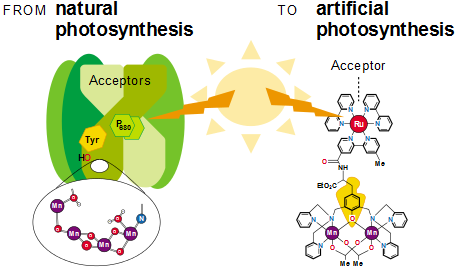What is Artificial Photosynthesis?
Artificial photosynthesis, the
technology of converting sunlight into liquid fuels, would be the greenest of
green technology if it can be done economically and on a large scale.Engineers
and scientists are trying to develop a technology that will use sunlight and
carbon dioxide to produce energy. This technology will have the dual benefit of
reducing carbon dioxide levels while also producing renewable fuel. Scientists
have proven that the technology is feasible, but problems still lie in scaling
up. Captured carbon storage and efficient conversion of solar energy into
electricity are challenges that, if overcome, will definitely pave the way of
success for this technology.

Is This a good alternative to other technologies?
Yes.Photovoltaic cell
technology is used in the production of solar panels, an expensive
semiconductor based system that doesn't store energy. Instead, it converts
sunlight for immediate use. Solar panels depend on sunlight, so bad weather
hinders their ability to create energy. Artificial photosynthesis, a chemical
based process, could provide an almost endless supply of much less expensive
and storable energy. Fossil fuel systems require mining and refining, depleting
natural resources, and adding pollutants to the air. Wind turbines and corn
products take up a lot of land. Artificial photosynthesis doesn't require
mining or land. It uses water and carbon dioxide, readily available resources,
in a process that removes pollutants from the air without harming the
environment.
Applications of Artificial
Photosynthesis
Fossil fuels are in short supply,
and they're contributing to pollution and global warming. Coal, while abundant,
is highly polluting both to human bodies and the environment. Wind turbines are
hurting picturesque landscapes, corn requires huge tracts of farmland and
current solar-cell technology is expensive and inefficient. Artificial
photosynthesis could offer a new, possibly ideal way out of our energy
predicament.
For one thing, it has benefits over
photovoltaic cells, found in today's solar panels. The direct conversion of
sunlight to electricity in photovoltaic cells makes solar power a weather- and
time-dependent energy, which decreases its utility and increases its price.
Artificial photosynthesis, on the other hand, could produce a storable fuel.
And unlike most methods of
generating alternative energy, artificial photosynthesis has the potential to
produce more than one type of fuel. The photosynthetic process could be tweaked
so the reactions between light, CO2 and H2O ultimately produce liquid hydrogen.
Liquid hydrogen can be used like gasoline in hydrogen-powered engines. It could
also be funneled into a fuel-cell setup, which would effectively reverse the
photosynthesis process, creating electricity by combining hydrogen and oxygen
into water.
The ability to produce a clean fuel
without generating any harmful by-products, like greenhouse gasses, makes
artificial photosynthesis an ideal energy source for the environment. It
wouldn't require mining, growing or drilling. And since neither water nor
carbon dioxide is currently in short supply, it could also be a limitless
source, potentially less expensive than other energy forms in the long run. In
fact, this type of photoelectrochemical reaction could even remove large
amounts of harmful CO2 from the air in the process of producing fuel. It's a
win-win situation.
Artificial photosynthesis is
experimental and will most likely remain so for 10 or more years . What plants
do naturally is not easy to reproduce, even though the process is fairly
well-understood. Finding a reliable catalyst to initiate the process has been a
challenge. Manganese has proven to be unstable, inefficient and impractical in
lab setups. Stability is an issue with other catalysts, both organic and
inorganic. Organic catalysts can degrade and cause reactions that damage fuel
cells. Inorganic metal-oxide catalysts are often not an abundant
resource.Recent developments include a noncorrosive solution for dye-sensitized
cells that previously could corrode fuel cell systems and the use of cobalt
oxide as a fast, stable and abundant metal oxide.The simple reality is that
little real progress has been made in artificial photosynthesis over the past
20 years – a fact dictated by the affordable price of oil. Doubts are being
raised as to whether researchers have a further 20 years to waste.
Artificial Photosynthesis Made Practical | MIT Technology Review. (n.d.). MIT Technology Review. Retrieved May 15, 2014, from http://www.technologyreview.com/news/521671/cheap-hydrogen-from-sunlight-and-water/
No comments:
Post a Comment